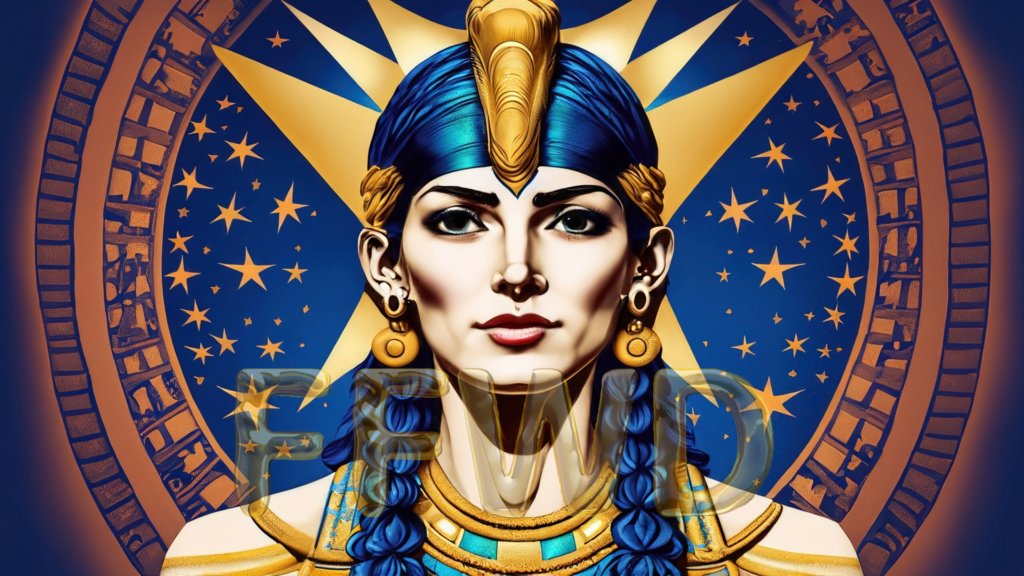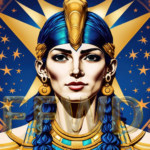
Venus Star point
What is the Venus Star Point (VSP)?
Simply put, the Venus star point is a conjunction, which is a major aspect of astrology.
The sun conjunct with Venus is a common aspect because the sun and Venus can never be more than 48 degrees apart.
And as a result, it is the only aspect that can be formed between these planets.
But it becomes auspicious when, approximately once every nine and a half months, the sun and Venus will align in one of the five signs, creating the outline of a star.
In another nine and a half months, she will undergo another conjunction with the sun.
But it only happens in the same sign every 4 years, currently in Gemini, Leo, Capricorn, Scorpio/Libra, and Pisces/Aries.
And when this happens, the positions make a five-pointed star, and astrologer Arielle Guttman popularized the name Venus Star Point from Venus cazimi.
Mythology of Inanna & Her Rebirth
In short, the story of Inanna, an ancient Sumerian goddess, is outlined below.
This story occurs well before Greek mythology, and Inanna is Venus in Mesopotamian mythology.
Her mythic tale involves her descent into the Underworld and subsequent return to the Upper World.
Anyway, Inanna had recently married Dumuzid, a local shepherd.
Not long after her union, her sister’s husband, Gugalanna, died, and Inanna traveled to her sister’s realm (the underworld) to observe the funeral rites and be there for her sister.
However, her sister, Ereshkigal, Queen of the Dead, does not want her there. Lucky for her, Inanna instructed her loyal servant, Ninshubur, to seek help if she didn’t return within three days.
But Inanna faces challenges at the first of the seven gates to the underworld and is left standing naked and powerless before her sister Ereshkigal.
Ereshkigal decides Inanna should be hung on a hook and left to rot like anyone else entering the underworld.
But Inanna was a fertility goddess, and the world above becomes barren, symbolizing the absence of her life-giving qualities.
Not long after Ninshubur seeks help, Inanna’s father-in-law, Enki creates two beings to rescue her.

Inanna regains her regalia (although she had changed for good), symbolizing resurrection.
However, to return, she must choose a substitute to replace her in the Underworld. Inanna chooses her husband, Dumuzid, because he never mourned her when she was gone.
But she soon feels guilty, and she offers herself in exchange for his release for part of the year, thus symbolizing the changing seasons and the cycle of life, death, and rebirth.
The story also symbolises the invisibility of Venus turning from an evening star to a morning star.
Morning Star and Evening Star
This Venus and Sun conjunction will either be the inferior or superior conjunction, also known as the morning star or evening star, lasting for about 584 days.
Venus is the brightest planet in the solar system.
Thus, in the morning, she looks like she is rising, and at night, she is visible.
Venus becomes invisible when she is in the heart of the sun.
When Venus is conjunct with the sun (the heart of the sun) and appears to move backward in the sky due to her orbit relative to Earth (trailing the sun), she becomes a new Venus and is reborn as a morning star.
When Venus is an evening star, she is ahead of the sun (not retrograde), conjuncts the sun, and continues to move more forward.
What does this all mean?
When Venus makes her shift from a morning star to an evening star, she starts a new cycle.
When she is a morning star, the energy feels fresher, like a new moon—the dawn of a new day.
There is a force of change that therefore heralds new beginnings, initiating new relationships, money ventures, and projects.
Sun conjunct Venus is a common aspect but approximately once every nine and a half months, the sun and Venus will align in one of the five signs, creating the outline of a star.
This is an ideal time for engaging in artistic endeavors.
Then, when Venus changes from a morning star to an evening star, it is similar to a full moon.
Venus, as the evening star, emphasizes contemplation, introspection, and receptivity.
It’s a period for fostering emotional connections, resolving conflicts, and nurturing existing partnerships. And you will reflect on existing relationships and values.
The evening star can be a perfect time to reassess what truly matters to you and to refine your sense of self-value and self-love
What’s Next?
Look for the last conjunction of the sun and Venus just before your birth, unless you were born during the conjunction.
If your Venus is in front of your natal sun, including a sign ahead, you will be an evening star.
If Venus is behind your natal sun, including a sign behind the sun, you will be a morning star.
After identifying if you have a morning or evening star, determine its sign based on your birthdate.
Either way, knowing your VPS placement can help you understand your relationships.





